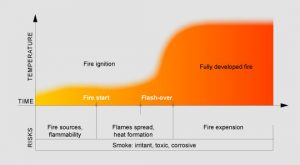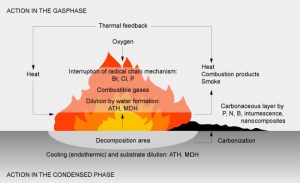According to Fire Safe Europe, each day thousands of fires are declared leading to the deaths of 4000 persons per year in Europe. From a financial point of the view, over 126 billion euros are spent across Europe on fire-related costs [1]. To reduce the risk of fire, flame-retardants started to be used in the seventies. This class of chemicals is applied to all types of furniture such as foam, electronics, or building insulation to prevent the ignition of fire or slow down its growth. Through the decades the presence of flame-retardant in our indoor environment has grown to the point of being omnipresent. However, during the past decades more and more studies have been pointing out flame-retardants. Their efficiency is questioned and more importantly, their multiple negative impacts on health are highlighted. Since their introduction in the seventies, many flame-retardants have been banned and removed from the market. Recently, the European Commission banned the use of halogenated flame-retardants in plastic enclosures and stands of electronic display.[2] In this context of raising awareness against flame-retardants, their benefits-risk balance is questioned.
Are flame-retardants an effective shield against fire or a chemical threat?
What are Flame-Retardants ?
Flame-retardants (FR) refer to a class of chemical substances added to combustible products to reduce the risk of ignition or slow the spread of flames. Hundreds of different types of FR exist and are distinguished in different types of class whether they contain bromine, chlorine, phosphorus, nitrogen, metals, or boron; the most widely used being brominated flame-retardants. FR are considered persistent, bioaccumulate, and can accumulate in people’s bodies or animals.[3]
Where are they?
Through the years FR have been added to multiple types of product to meet flammability regulations and are now omnipresent in our environment. Millions of tons of FR are consumed each year worldwide [4]. In homes, FR can be found in foams, mattresses, sofas, carpets but also computers, television, wires, and building insulation material… In transportation, FR are in seats, seat covers, parts of cars, trains, or airplanes. [3] However, FR are not only present in furniture, but also in the outdoor environment. They constitute nowadays a bio pollutant as they are present in the air, water, soil and have a low biodegradability. Studies have even shown the presence of retardants in wildlife such as fish, birds [5], or even in the Arctic wildlife. [6]

Figure 1– Example of where Flame-Retardants are used [8]
How are we exposed to Flame-Retardants?
As these chemicals are surrounding us, our exposure to them is highly important. The most common way of exposure in households is dust. Indeed, FR can off-gas from furniture and settle into dust, the contaminated dust is then ingested by occupant by hand-to-mouth contact. Studies have shown children are more exposed than adults [7] which could be linked to their proximity to the floor and hand-to-mouth behavior. These chemicals can also leak into the air, water, and soil during manufacture. As they are very resistant and difficult to break down, they tend to stay in the environment.
To reduce exposure, it is recommended to reduce dust level down by regularly mopping, vacuuming with a HEPA filter, and having a good ventilation system. As the contamination is down by hand-to-mouth effect, regular hand washes are advised as well. Finally, purchase flame-retardant-free products. [8]
What are the benefits of Flame-Retardants?
FR were widely used to protect against fire in the seventies for acting as a shield against fire as they act on 3 phases of fire:
- Ignition: Prevent ignition, possibility the flames self-extinguish
- Flame spread: Reduce heat release, slow the spread of flames, and delay the flash-over
- Fire penetration: Prevent the fire to move to an adjacent room
To better understand the impact of FR, it is interesting to first look at the mechanisms of fire. It will occur when oxygen, fuel, and heat are present.
During the start of a fire, the solid is heated, when its breaking point is reached, flammable gases are released and react with oxygen. This reaction is responsible for flames. In case the solid is not heated to its breaking point no flammable gases will be released and the solid will self-extinguish. [9] In case a fire starts in a building, it can easily go from a small ignition to a fully developed fire. The different principal phases are described in figure 2[10]. FR mostly act on the decisive phase of initiating fire to prevent the spread and generalization.

Figure 2– Principal phases of fire development within a building [10]
FR can interferer during combustion thanks to physical or chemical actions in the different phases (gas, liquid, solid). It exists 3 main methods for flame retardance:
Vapor phase inhibition: Chemical action which aims to interfere with the combustion process by eliminating the chemical chain reaction leading to flame formation. Once the flames are reduced the system cools down and the flames will keep reducing. The most used flame retardant, in this case, is Bromine present in plastic, electronics, foams (…) [9,10,11]
Solid phase char flame-retardants: Once the fire has begun, FR build up a carbonated char protection layer which have two main advantages: prevent the release of flammable gases but also protect the underlying material from the heat of the flames. A typical char flame retardant is Phosphorus present in foam mattresses, textiles, television (…) [9,10,11]
Quench and cool systems: Physical action where the product is coated with hydrated minerals. In presence of heat, they will release inter gases (such as water) which will allow the system to cool down and avoid the release of flammable gasses. Aluminum and magnesium hydroxides are used in paints, wire, cables (…) [9,10,11]

Figure 3– Different modes of action of Flame-Retardants [10]
The main advantage of FR is to reduce the risk of fire and in case of fire slow its growth allowing to gain precious time for the occupants. According to the National Institute of Standards and Technology in the US, escape time can be up to 15 times longer when flame-retardant are present which significantly increases the chances of survival for occupants.[12] In the aeronautical field, flame-retardants have been credited twice, in the past, to have played a vital role in helping passengers escaping an airplane after its crash. As an illustration, in the passenger plane crash in Toronto in 2005, it helped to save 309 passenger lives [13]
Do they represent a risk for health and the environment?
Through the last decades, more and more studies have pointed out the negative impact FR could have on health, smoke toxicity, and the environment.
- Increase of the smoke toxicity level during fire: The most important cause of death during a fire is smoke. As the products in households have drastically changed, the proportion of fire deaths from smoke has been multiplied by 4 from the 1950s to 2000s in the UK [14].More recently, studies [15,16] have shown that the smoke released in case of the presence of certain flame-retardants (such as bromine) could increase the yield of HCN and CO known as dangerous components. The use of flame-retardants would lead to more toxic but also thicker smoke increasing the danger of it and complicating the escape of the occupants.
- Health issue due to exposure: According to the National Institute of Environmental Health Science, important exposure to FR is linked to negative impacts on the health of humans and animals. FR are associated with endocrine and thyroid disruption, cancer (such as breast or thyroid cancer), immune and reproductive system, neurologic function and could have an impact on the development of fetuses and children. [4,17]
- Environment: FR are mobile in the environment as well as persistent, hence they accumulate in the wildlife and can be found in animals as well as in plants including BFR. BFR bioaccumulation as well as concern about their toxicity raises awareness. Furthermore, processes (abiotic, biotic) could change the composition of FR’s which could lead to more pollution in the outdoor environment. [18]
Conclusion
For 50 years, flame-retardants have been more and more present in our environment. Even though they represent an effective shield against fire, their presence is becoming controversial as their negative impacts on health are highlighted. However, hundreds of flame-retardants exist with each of them have specific physical, chemical properties, varying efficiency against fire, and different impacts on humans and the environment. This diversity makes it difficult to answer the question “Flame-retardants: friends or foes?”. Regulating this type of product is then complex, especially that standards vary a lot from a country to another. Another issue is the persistence of flame-retardants, even when they are banned, in the environment but also in households as not everyone can afford to change their furniture. Nowadays new types of flame-retardants are being developed to be less toxic and more sustainable, they refer as Green Flame-Retardants.
References :
[1]Fire Safe Europe. “A European Fire Safety Strategy Is Needed!,” June 19, 2017. https://firesafeeurope.eu/european-fire-safety-strategy-needed/. [2] Commission Regulation (EU) 2019/2021 of 1 October 2019 laying down ecodesign requirements for electronic displays pursuant to Directive 2009/125/EC of the European Parliament and of the Council, amending Commission Regulation (EC) No 1275/2008 and repealing Commission Regulation (EC) No 642/2009 (Text with EEA relevance.), Pub. L. No. 32019R2021, 315 OJ L (2019). http://data.europa.eu/eli/reg/2019/2021/oj/eng.[3] National Institute of Environmental Health Sciences. “Flame Retardants.” Accessed May 2, 2021. https://www.niehs.nih.gov/health/topics/agents/flame_retardants/index.cfm.
[4] Allysona. “Flame Retardants.” SixClasses.Org(blog). Accessed May 2, 2021. https://www.sixclasses.org/videos/flame-retardants. [5] Wit, Cynthia A de. “An Overview of Brominated Flame Retardants in the Environment.” Chemosphere46, no. 5 (February 1, 2002): 583–624. https://doi.org/10.1016/S0045-6535(01)00225-9. [6] “Arctic Wildlife Threatened by Flame Retardant | WWF.” Accessed May 2, 2021. https://www.wwf.eu/?13399/Arctic-wildlife-threatened-by-flame-retardant. [7] Butt, Craig M., Johanna Congleton, Kate Hoffman, Mingliang Fang, and Heather M. Stapleton. “Metabolites of Organophosphate Flame Retardants and 2-Ethylhexyl Tetrabromobenzoate in Urine from Paired Mothers and Toddlers.” Environmental Science & Technology48, no. 17 (September 2, 2014): 10432–38. https://doi.org/10.1021/es5025299. [8] “Flame Retardants: Why They’re in Our Homes and How To Avoid Them | Environmental Working Group.” Accessed May 2, 2021. https://www.ewg.org/news-insights/news/flame-retardants-why-theyre-our-homes-and-how-avoid-them. [9] “How Do Flame Retardants Work?,” August 5, 2016. https://www.polymersolutions.com/blog/how-do-flame-retardants-work/. [10] “Fire Behaviour | FLAMERETARDANTS-ONLINE.” Accessed May 2, 2021. https://www.flameretardants-online.com/fires/fire-behaviour. [11] “Types of Flame Retardants_Company News_Novista Chemicals – The Pioneer of Flame Retardant.” Accessed May 2, 2021. http://www.novistagroup.com/show.asp?id=2031. [12] Landry, Susan D. “Flame Retardants – Fire Safety & Regulatory Status,” n.d., 25., https://www.nist.gov/system/files/documents/el/fire_research/2-Landry.pdf [13] Intelligent Aerospace. “Flame-Retardant Materials Credited with Helping to Protect Asiana Airlines Passengers in San Francisco Crash,” July 2013. https://www.intelligent-aerospace.com/commercial/article/16539804/flameretardant-materials-credited-with-helping-to-protect-asiana-airlines-passengers-in-san-francisco-crash. [14] Alarifi, Abdulaziz (Aziz), Roth Phylaktou, and Gordon Andrews. “What Kills People in a Fire? Heat or Smoke?,” 2016. https://www.researchgate.net/publication/299080072_What_Kills_People_in_a_Fire_Heat_or_Smoke [15] McKenna, Sean T., Robert Birtles, Kathryn Dickens, Richard G. Walker, Michael J. Spearpoint, Anna A. Stec, and T. Richard Hull. “Flame Retardants in UK Furniture Increase Smoke Toxicity More than They Reduce Fire Growth Rate.” Chemosphere196 (April 1, 2018): 429–39. https://doi.org/10.1016/j.chemosphere.2017.12.017. [16] Molyneux, Shirley, Anna A. Stec, and T. Richard Hull. “The Effect of Gas Phase Flame Retardants on Fire Effluent Toxicity.” Polymer Degradation and Stability, Special Issue Based on the 14th European meeting on Fire Retardancy and Protection of Materials, held at Ecole Nationale Supérieure de Chimie de Lille (U. Lille-1), France, July 2013, 106 (August 1, 2014): 36–46. https://doi.org/10.1016/j.polymdegradstab.2013.09.013. [17] “Flame Retardants — The Collaborative on Health and the Environment.” Accessed May 2, 2021. https://www.healthandenvironment.org/environmental-health/environmental-risks/chemical-environment-overview/flame-retardants. [18] Segev, Osnat, Ariel Kushmaro, and Asher Brenner. “Environmental Impact of Flame Retardants (Persistence and Biodegradability).” International Journal of Environmental Research and Public Health6, no. 2 (February 2009): 478–91. https://doi.org/10.3390/ijerph6020478.